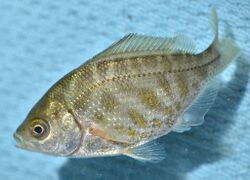Biology:Tule perch
| Tule perch | |
|---|---|

| |
| Hysterocarpus traskii pomo | |
| Scientific classification | |
| Domain: | Eukaryota |
| Kingdom: | Animalia |
| Phylum: | Chordata |
| Class: | Actinopterygii |
| Family: | Embiotocidae |
| Genus: | Hysterocarpus Gibbons, 1854 |
| Species: | H. traskii
|
| Binomial name | |
| Hysterocarpus traskii Gibbons, 1854
| |
| Synonyms[2] | |
| |
The tule perch (Hysterocarpus traskii) is a surfperch (Embiotocidae) native to the rivers and estuaries of central California . It is the sole member of its genus, and the only freshwater surfperch.
The tule perch is small, at most 15 centimetres (5.9 in) in length, and deep-bodied, with a defined hump between the head and the dorsal fin. Color is variable, with a dark back that may have a bluish or purplish cast, and a whitish or yellowish belly. The sides may have a pattern of narrow or wide bars; the frequency of barred patterns varies according to subspecies. The dorsal fin has a noticeable ridge of scales running along its base, and consists of 15-19 spines followed by 9-15 soft rays. The anal fin has three spines and 20-16 soft rays, while the pectoral fins have 17-19 rays.
They are fish of the lowlands, inhabiting lakes, sloughs, streams, and rivers, generally in areas with beds of vegetation or overhangs. They generally gather in groups, sometimes in large numbers. Their diet is primarily small invertebrates sucked up from the bottom or picked from the midwater column.
Three subspecies have been described:[2]
- Hysterocarpus traskii traskii Gibbons, 1854, the Russian River tule perch, originally occurred throughout Clear Lake, the Russian River, the Sacramento River-San Joaquin River and out into the estuaries around San Francisco Bay and the Pajaro River-Salinas River drainages. It is still common as far north as the Pit River, although it has mostly disappeared from the San Joaquin basin. The only unbarred fish occur in this subspecies, about 43% existing in this color pattern.
- Hysterocarpus traskii pomo Hopkirk, 1974 is found in the Central Valley drainages.
- Hysterocarpus traskii lagunae Hopkirk, 1974
The formal description of the tule perch was first read by W. P. Gibbons at a meeting of the California Academy of Natural Sciences on May 15, 1854, and then published in the San Francisco newspaper The Daily Placer Times and Transcript on May 18, making it a rare case of a new species being published in a newspaper rather than book or scientific journal. Gibbons chose the genus name Hysterocarpus "womb-fruit" referring to the livebearing common to all surfperches. The specific name honours John B. Trask (1824–1879), a friend of William P. Gibbons. Trask was a physician and amateur geologist, and a founding member of the California Academy of Sciences.[3]
References
- ↑ NatureServe (2013). "Hysterocarpus traskii". IUCN Red List of Threatened Species 2013: e.T62221A18230342. doi:10.2305/IUCN.UK.2013-1.RLTS.T62221A18230342.en. https://www.iucnredlist.org/species/62221/18230342. Retrieved 20 November 2021.
- ↑ 2.0 2.1 "Hysterocarpus traskii Gibbons, 1854". Integrated Taxonomic Information System. https://www.itis.gov/servlet/SingleRpt/SingleRpt?search_topic=TSN&search_value=553322.
- ↑ "Subseries OVALENTARIA: Incertae sedis". The ETYFish Project Fish Name Etymology Database. Christopher Scharpf and Kenneth J. Lazara. 29 March 2018. http://www.etyfish.org/ovalentaria/.
- "Hysterocarpus traskii". Integrated Taxonomic Information System. https://www.itis.gov/servlet/SingleRpt/SingleRpt?search_topic=TSN&search_value=553322. Retrieved 18 April 2006.
- Peter B. Moyle, Inland Fishes of California (University of California Press, 2002), pp. 424–428
- Froese, Rainer and Pauly, Daniel, eds. (2013). "Hysterocarpus traskii" in FishBase. April 2013 version.
- University of California, Division of Agriculture and Natural Resources; California Fish Website; California Fish Species
Wikidata ☰ {{{from}}} entry
 |


